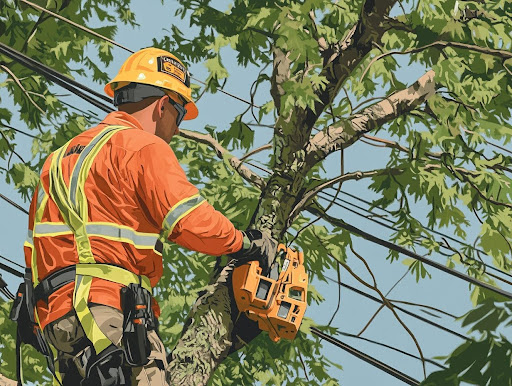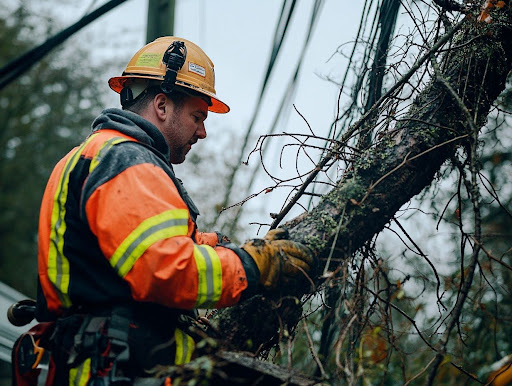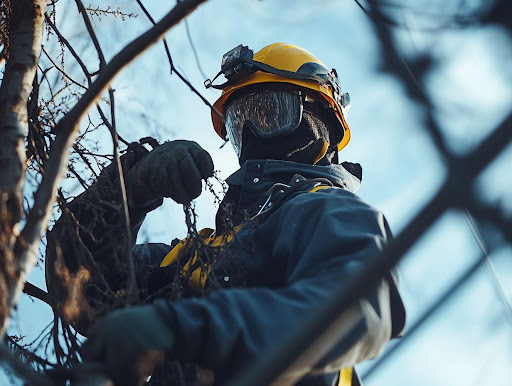Safety Guidelines for Tree Removal Near Power Lines
In the context of preserving the safety and integrity of our communities, the removal of trees in proximity to power lines is of paramount importance. Trees encroaching upon electrical lines can present significant hazards, ranging from potential power outages to increased fire risks. This article delves into the dangers associated with trees near power lines, the ramifications of failing to undertake appropriate removal, and the critical safety guidelines that should be adhered to. Additionally, it provides a comprehensive overview of the step-by-step process of tree removal, enabling individuals to make informed decisions that contribute to a safer environment.
Key Takeaways:
- Removing trees near power lines is crucial to avoid risks of electrocution, power outages, and property damage.
- Follow safety guidelines such as hiring professionals, obtaining permits, and inspecting the tree and power lines before removal.
- The tree removal process includes assessment, trimming, removal, and post-removal maintenance to ensure safe and efficient removal.
Why is Tree Removal Near Power Lines Important?
Tree removal in proximity to power lines is a critical concern for homeowners and the community in the Central Coast, NSW, Australia, as it directly affects safety, vegetation management, and regulatory compliance.
The presence of trees near power lines can pose significant risks not only to the electrical infrastructure but also to residents’ safety. Arborists emphasise the necessity of proper pruning and maintenance to mitigate hazards that could result in power outages or dangerous situations, particularly during adverse weather conditions such as strong winds, bushfires, and high winds.

What are the Risks of Trees Near Power Lines?
Trees near power lines pose significant risks that can compromise community safety and infrastructure reliability, including obligations under the Electricity Safety Act 1988.
These potential hazards stem from various factors, underscoring the critical need for vigilant management and maintenance. For example, branches that encroach upon power lines can create substantial electrical hazards, particularly during storms when falling limbs can lead to outages or even unauthorised connections, posing serious threats to individuals nearby.
Moreover, during bushfire seasons, trees’ proximity to electrical equipment presents a considerable fire risk, as any spark could ignite surrounding vegetation, resulting in catastrophic outcomes. Additionally, high winds can exacerbate these dangers by causing unstable trees to collapse, disrupting electrical services and endangering residents.
Regular inspections and proactive safety measures are imperative to mitigate these risks effectively. Communities should prioritise:
- Frequent assessments of tree health and their proximity to power lines, according to Energy Safe Victoria guidelines.
- Timely trimming or removal of hazardous branches.
- Education for residents on safe planting practices.
By implementing these strategies, communities can significantly enhance the safety and reliability of local infrastructure.
What are the Consequences of Not Removing Trees Near Power Lines?
Failing to remove or manage trees adequately near power lines can result in significant consequences for homeowners and the broader community, including property damage and increased safety hazards.
Specifically, when branches encroach upon electrical infrastructure, the risk of power outages escalates considerably. Such outages can disrupt daily activities, impact businesses, and lead to expensive repairs. Furthermore, proximity to trees can create fire hazards, particularly during dry seasons when even a small spark has the potential to ignite a wildfire, endangering both homes and lives. Neglecting tree management can also seriously damage property, as falling branches can break roofs, shatter windows, or even cause injury to individuals.
Homeowners must recognise that tree management has legal and financial ramifications. If a tree causes injury or damage due to insufficient maintenance, the affected party may seek compensation through legal claims.
Consequently, maintaining proper vegetation management and ensuring compliance with safety regulations is not only advisable but imperative.
What are the Safety Guidelines for Tree Removal Near Power Lines?
Implementing safety guidelines for tree removal near power lines is crucial to safeguard the community and the individuals engaged in the process. These guidelines include:
- Engaging professional services
- Obtaining the required permits
- Conducting comprehensive inspections
- Utilising appropriate equipment
- Adhering to established safety protocols and regulations
By following these guidelines, homeowners can effectively mitigate the risks associated with vegetation management, while arborists can ensure that compliant and safe practices are maintained throughout the removal process.

Hire a Professional Tree Removal Service with Ausgrid-certified contractors.
Hiring a professional tree removal service is essential for safely managing trees near power lines and ensuring compliance with local regulations.
The benefits of engaging certified arborists extend beyond mere tree removal in urban environments. These professionals possess specialised knowledge, particularly in high-risk scenarios such as removing trees near power lines. Their training enables them to assess trees’ condition and stability accurately and develop strategies that prioritise safety and efficiency.
- A significant advantage of professional oversight is ensuring that all local safety regulations and industry standards are adhered to meticulously.
- Confirming a tree service’s licences and insurance provides peace of mind, safeguarding against potential liabilities during removal.
- Ultimately, selecting a certified arborist mitigates risks and contributes to your landscape’s longevity.
Therefore, engaging skilled professionals is vital to preserving safety and aesthetics in outdoor spaces.
Obtain Necessary Permits and Permissions
Before proceeding with tree removal near power lines, homeowners must obtain their local council’s requisite permits and permissions to ensure compliance with regulations and maintain safety.
Anyone involved in landscaping or home improvement projects must have a comprehensive understanding of this process. Typically, councils establish distinct guidelines that govern the timing and methodology of tree removal.
- Application Process: Homeowners are required to complete an application that outlines the justification for the proposed tree removal.
- Assessment: Local councils often assess the tree’s health, location, and potential impact on the surrounding area.
- Documentation: It may be necessary to submit photographs and maps illustrating the tree’s proximity to power lines and other structures.
By diligently following these steps, individuals reduce the likelihood of potential legal complications and contribute to the safe management of their environment, thus promoting responsible practices within their community.
Inspect the Tree and Power Lines Before Removal, with proper notifications to homeowners.
Conducting a thorough inspection of the tree and power lines before removal is an essential step in ensuring the safety of the operation and mitigating potential hazards.
During this inspection, several critical factors warrant close attention. Evaluating the tree’s health is of utmost importance; indications of disease, decay, or structural weakness can significantly influence the strategies employed during the removal process.
The proximity to power lines is another key consideration, as it directly relates to the risks of electrical hazards during cutting operations. Additionally, assessing the surrounding environment, including nearby structures and the slope of the land, can provide valuable insight into potential safety risks.
By performing a detailed assessment of these elements, professionals are better equipped to identify hazards effectively. This allows them to formulate comprehensive removal strategies prioritising safety and efficiency.
Engaging local utility companies may also be advantageous in managing the risks associated with power lines. Ultimately, these inspections protect the individuals involved and contribute to a more responsible approach to tree removal.

Use Proper Equipment and Techniques
Utilising appropriate equipment and techniques during tree removal is crucial for ensuring safety and effectiveness, particularly when operating near powerlines.
In these challenging circumstances, tree removal professionals must comprehensively understand the various types of equipment available. This begins with personal protective gear, such as helmets and gloves, which shield arborists from unforeseen hazards.
Chainsaws and ropes are essential for professionals to maintain control during cutting operations. Techniques such as rigging and pruning are vital for safely dismantling a tree without damaging nearby structures or landscapes. Adherence to local regulations guarantees that each removal is performed legally and responsibly, thereby minimising the risk of accidents.
- Protective Equipment: Helmets, gloves, and eye protection.
- Cutting Tools: High-quality chainsaws and handsaws.
- Safety Gear: Harnesses and ropes for secure rigging.
These measures not only enhance the safety of arborists but also cultivate trust within the communities they serve.
Follow Safety Protocols and Procedures
Adhering to established safety protocols and procedures is essential for arborists and homeowners when removing trees near power lines. Compliance with these regulations safeguards lives and prevents significant property damage.
Implementing effective safety measures is critical for minimising the risks associated with tree removal. Both arborists and homeowners must prioritise adherence to safety protocols, which may include the following:
- Risk Assessment: Conduct a thorough evaluation of the surrounding area to identify potential hazards, such as unstable ground, nearby structures, or electrical lines.
- Use of Personal Protective Equipment (PPE): Ensure that all personnel are equipped with appropriate protective gear, including hard hats, gloves, and protective eyewear.
- Clear Communication: Establish a designated safe zone and maintain open lines of communication to avoid misunderstandings during the operation.
- Emergency Procedures: Develop and routinely practise an emergency response plan to address potential accidents.
Homeowners have a crucial role in this process by ensuring that the necessary permits are obtained and local regulations are followed, promoting a safe environment for all parties involved.
What is the Process of Tree Removal Near Power Lines?
The process of tree removal near power lines involves several critical steps, including assessment and planning, pruning, tree removal, and the proper disposal of debris, followed by post-removal inspection and maintenance.
Each step is carefully designed to ensure safety and compliance with relevant regulations while effectively managing vegetation. Homeowners and arborists must collaborate to develop a comprehensive plan that takes into account the specific risks associated with trees’ proximity to power lines, thereby protecting both the electrical infrastructure and the surrounding community.

Assessment and Planning
Assessment and planning are the foundational steps in tree removal near power lines, as they facilitate the identification of potential hazards and the development of an effective removal strategy.
A comprehensive evaluation is essential for understanding not only the tree’s condition but also its proximity to power lines. This assessment should include examining the tree’s height, health, and root stability, which can significantly influence its potential to interfere with electrical infrastructure. Evaluating the site allows for identifying surrounding features that may pose risks during removal.
- Proper assessment aids in recognising dead branches that may fall unexpectedly.
- It also assists in evaluating the impact on nearby structures and the overall landscape.
- By conducting this evaluation, compliance with local safety regulations can be ensured.
A meticulously developed plan safeguards the individual performing the removal and protects the integrity of the local community and its standards.
Tree Trimming and Pruning
Tree pruning and trimming are critical practices in managing trees located near power lines. They facilitate safer removal while minimising risks associated with overgrown branches.
When performed by qualified professionals, these practices enhance the overall health of the tree and ensure that potential hazards are effectively managed. Regular maintenance is crucial for compliance with local tree safety regulations and environmental standards.
Proper tree care techniques, such as selective pruning, can significantly mitigate the chances of branches interfering with electrical lines, reducing the risk of power outages or fire hazards. The benefits of effective tree management include:
- Enhanced visibility and access for utility crews, simplifying maintenance tasks.
- Improved air circulation and sunlight exposure promote healthier tree growth.
- Increased property safety by reducing the likelihood of falling branches during storms.
Engaging with certified arborists guarantees that pruning and trimming are conducted appropriately, preserving the tree’s structural integrity while prioritising safety and compliance with regulatory standards.
Tree Removal and Disposal
The tree removal and disposal process must be carried out with the utmost care to ensure safety and proper debris management, particularly when work is being conducted near powerlines, following guidelines set by Ausgrid and Energy Safe Victoria.
The complexity of this undertaking cannot be underestimated. A comprehensive range of safety measures must be implemented to protect both the workers and the surrounding environment. First and foremost, personal protective equipment (PPE), including hard hats, gloves, and eye protection, is vital to safeguard against falling branches and sharp debris during removal.
Additionally, conducting a thorough risk assessment is crucial to identify potential hazards in the vicinity, such as powerlines, buildings, and pedestrian areas, which the Electricity Industry Performance Code governs.
- Employing proper cutting techniques is essential to minimise the risk of accidents.
- Debris must be handled with care to prevent injuries.
- Using ropes and harnesses can aid in controlling the fall of larger limbs and the tree itself.
Once the tree has been removed, appropriate disposal methods must be followed to ensure the materials do not pose a hazard. Effective debris disposal may involve chipping, recycling, or transporting waste to regulated dumping sites. This diligent approach complies with environmental regulations and enhances community safety by mitigating hazards associated with improperly discarded materials.
Post-Removal Inspection and Maintenance
After the tree removal process, conducting a post-removal inspection and maintenance is imperative to ensure the area is safe and free from hazards, particularly in proximity to power lines.
This step is essential as it helps identify any remaining risks that could endanger the surrounding environment and individuals who interact with it. Inspections not only guarantee compliance with safety regulations but also provide reassurance to local communities.
Moreover, implementing ongoing maintenance practices is critical in preventing future issues related to vegetation encroaching on power lines. Regular monitoring of the area and effective trimming and removal strategies ensure that potential hazards are addressed promptly.
- Conduct regular site assessments.
- Implement tree trimming schedules.
- Communicate openly with local authorities regarding risks.
By adopting these proactive measures, stakeholders can significantly contribute to safety and environmental stewardship.
Conclusion: Importance of Proper Tree Removal Near Power Lines
Proper tree removal in proximity to power lines is essential for maintaining community safety and ensuring compliance with vegetation management regulations in the Central Coast, NSW, Australia, through accredited training courses.
Homeowners and community members must understand the risks associated with overgrown vegetation. Trees encroaching upon power lines significantly threaten public safety and increase the risk of power outages and fire hazards.
To mitigate these risks, it is advisable to implement the following strategies:
- Conduct regular inspections of trees, considering species and their surrounding areas, to identify potential hazards.
- Engage with local authorities and power companies, such as Ausgrid, to obtain guidance on safe distances and clearance between trees and power lines, which can provide invaluable assistance.
- Collaborate with neighbours to maintain healthy landscapes, strengthen community ties and ensure mutual safety.
By prioritising routine tree maintenance and adhering to established regulations, homeowners contribute positively to their neighbourhoods, fostering a safer and more responsible environment for all residents.
Frequently Asked Questions
The first and most crucial safety guideline is always to assume that power lines are live and dangerous. Before tree removal near power lines, contact your local power company and follow their safety protocols.
Tree removal near power lines poses a serious risk of electrocution and other safety hazards. Following safety guidelines, as outlined in the Electricity Safety Act 1988 and the Electricity Safety (General) Regulations 2019, helps ensure the safety of the tree removal professionals and anyone in the surrounding area.
If you notice a tree growing near power lines, immediately refer to the Electricity Industry Performance Code. Contact your local power company and a professional tree removal service to assess the situation and safely remove the tree if necessary.
No, it is highly recommended that you never attempt to remove a tree near power lines on your own. This hazardous task should only be performed by trained professionals with the proper equipment and knowledge to remove the tree safely.
If a tree falls on a power line, it is crucial to stay away from the area and contact your local power company immediately. Do not attempt to remove the tree or touch the power lines as they may still be live and pose a serious risk of electrocution.
Before starting tree removal near power lines, it is essential to check the weather forecast. Do not attempt to remove a tree near power lines during inclement weather, as this can increase the risk of electrocution. Also, wear proper protective equipment and follow all safety protocols your local power company outlines.
